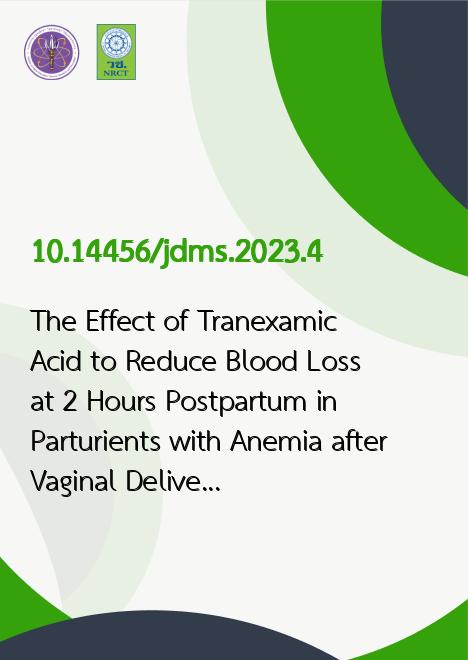
|
The Effect of Tranexamic Acid to Reduce Blood Loss at 2 Hours Postpartum in Parturients with Anemia after Vaginal Delivery: A Double-blind Randomized Controlled Trial |
|---|---|
| รหัสดีโอไอ | |
| Creator | Damras Limthongnopakun |
| Title | The Effect of Tranexamic Acid to Reduce Blood Loss at 2 Hours Postpartum in Parturients with Anemia after Vaginal Delivery: A Double-blind Randomized Controlled Trial |
| Publisher | สำนักวารสารกรมการแพทย์ |
| Publication Year | 2566 |
| Journal Title | Journal of the Department of Medical Services |
| Journal Vol. | 48 |
| Journal No. | 1 |
| Page no. | 35-43 |
| Keyword | Tranexamic acid, Parturients with anemia, Vaginal delivery, Double-blind ramdomized controlled trial |
| URL Website | https://he02.tci-thaijo.org/index.php/JDMS |
| Website title | วารสารกรมการแพทย์ |
| ISSN | 2697-6404 |
| Abstract | Background: Postpartum hemorrhage is an emergency and life-threatening symptom to postpartummothers. Those with anemia have an increased risk of postpartum hemorrhage at 50% compared to normalpregnancy. Objectives: To examine the effectiveness of Tranexamic acid for reducing blood loss 2 hourspostpartum in women with anemia after vaginal delivery. Method: A Double-blind Randomized Controlled Trialstudy was conducted. The total sample size was 80 equally distributed in both groups. Inclusion criteria: ? 37weeks of gestation, singleton pregnancy, planned vaginal delivery, and hematocrit at delivery room < 33 %.A study group received 1 g of tranexamic acid (20 mL in volume) and the control group received 0.9% NSS 20 ml.The study was conducted between November 2021 and March 2022. The primary outcomes were to compare themean blood loss and hematocrit values 2 hours after birth. The secondary outcomes were to examine the incidenceof postpartum hemorrhage and adverse events. Statistics were analyzed using the Chi-square test and independentt-test. Results: There were no statistical differences in age, number of pregnancies, parity, gestational age, hematocrit,perineal incision, and birth weight of both groups. The mean blood loss was significantly lower in the study groupthan in the control group (175.48 ml ? 110.90 ml and 368.13 ml ? 299.70 ml, p < .001). There were no statisticaldifferences in adverse events of both groups. Conclusions: Tranexamic acid 1 g intravenously effectively reducesblood loss at 2 hours postpartum in parturients with anemia after vaginal delivery. |